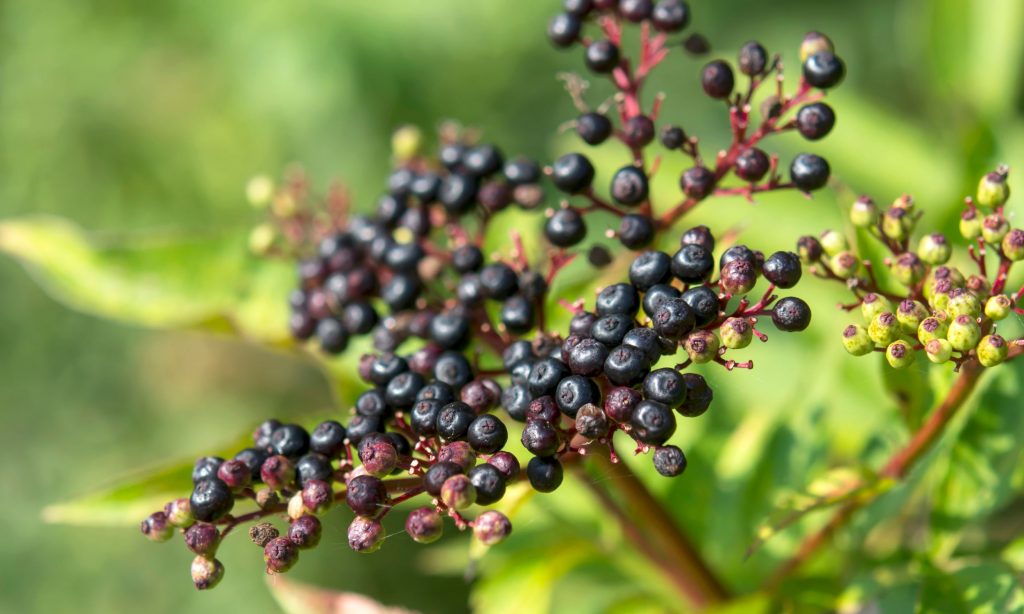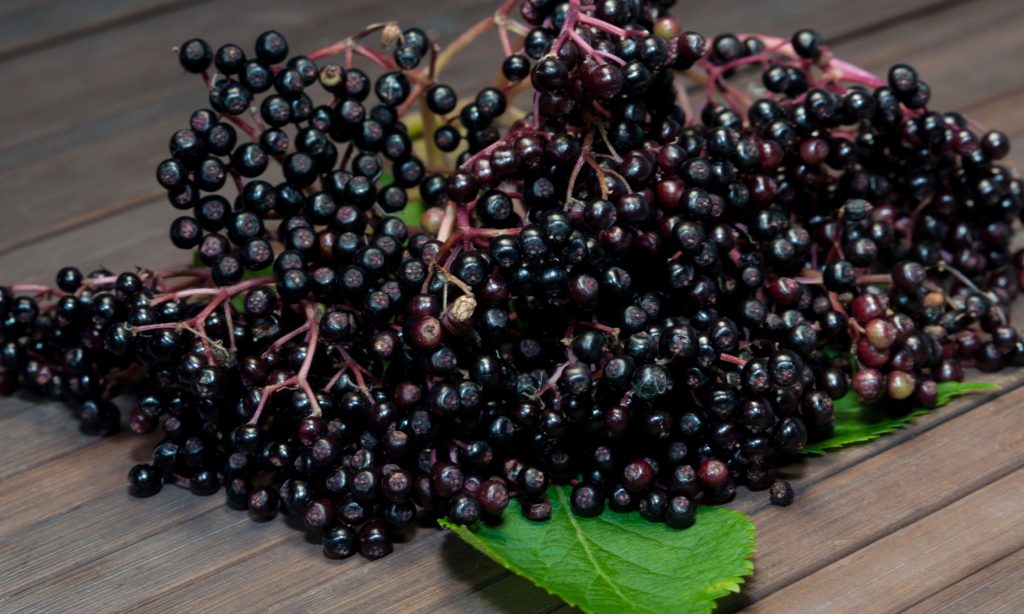Growing Elderberries
Looking for a delicious and easy-to-grow addition to your garden? Elderberry bushes are a great option! Not only do they produce tasty berries, but they also provide medicinal benefits. Plus, elderberry bushes are hardy and can thrive in a variety of climates. Read on to learn more about growing your own elderberry bushes.
Growing elderberries is easy and only requires a few simple steps. First, choose a sunny spot in your yard that has well-drained soil. Then, dig a hole that is twice the width of the root ball and just as deep. Next, remove the elderberry bush from its container and loosen the roots before placing it in the hole. Once the bush is in place, fill in the hole with dirt and water it well. Finally, Mulch around the base of the plant to help retain moisture and keep weeds at bay. With just a little effort, you can enjoy fresh elderberries for years to come.
Disclosure: Some of the links below are affiliate links, meaning, at no additional cost to you, I will earn a commission if you click through and make a purchase.
What are elderberry bushes and what do they look like?
Elderberry bushes are a type of shrub that is native to North America. They typically grow to be between six and twelve feet tall, with slender branches and small, dark-green leaves. The flowers are white or pale-pink, and they grow in clusters. The berries are dark-purple or black, and they ripen in the summertime.
Elderberries can be used to make jams, pies, and wines. They are also known for their medicinal properties, and they have been used to treat colds and flu for centuries. Today, elderberry supplements are widely available, and many people take them as a preventative measure during the winter months.
Why grow elderberry bushes
Growing elderberries is a great way to add color and interest to your garden. These shrubs are known for their clusters of small, dark berries that are perfect for making jams and pies.
Elderberries are also a good source of vitamins A and C, and they can be used to make herbal teas. In addition to being delicious and nutritious, elderberries are easy to grow and care for.
They are tolerant of poor soil conditions and require little water once established. With a little effort, you can enjoy fresh elderberries for many years to come.

Elderberry Varieties
Black elderberry (Sambucus nigra), which is native to Europe, but has naturalized in much of Asia and North America. Another very similar species of black elderberry is the American Elderberry (Sambucus canadensis), which is native to eastern North America.
Blue Elderberry (Sambucus nigra ssp. cerulea), which is native to western North America.
When searching nurseries and online plant stores for elderberry varieties, you will also find many ornamental types such as Black Lace and Variegated. They are all different subspecies of Sambucus nigra.
As far as I’ve seen, most of these species still have edible berries, but I’m not sure if they have the same medicinal benefits (my guess is that they probably do, being that they are subspecies to the medicinal type Sambucus nigra).
There is also red elderberry (Sambucus racemosa), that is native to the Pacific Northwest. Their berries are toxic when raw and they must be cooked prior to eating.
Just take note that all elderberry varieties contain some amount of toxicity raw, and when eaten can range from unpleasant tasting to stomach upsetting for some people. Others will have no problems and love the taste. Any toxins will be eliminated when cooked.
Where to Get Elderberry Starts and Seeds
If you don’t want to grow elderberries from cuttings, you can also purchase them as starts. These tend to come in gallon or half gallon size pots. They can also be grown from seed.
Raintree Nursery has a good selection of different elderberry variety starts.
Strictly Medicinal Seeds has a nice selection of both live plants and seeds.
You can also try your local nursery, many are starting to carry elderberry now!
Elderberries are so easy to grow and require very little maintenance, there’s no reason to not grow your own herbal medicine!

How to plant elderberry bushes
Elderberries are best planted in the spring, after the last frost.
Choose a spot in your garden that gets full sun and has well-drained soil.
To prepare the bed, dig a hole that’s twice as wide and deep as the root ball of your plant.
Gently loosen the roots before planting.
Set the plant in the hole so that the crown (where the roots meet the stems) is level with the soil surface.
Backfill with soil and water deeply.
Once your elderberry bush is planted, give it a slow steady watering once a week during its first growing season. After that, you can reduce watering to once every two weeks.
Fertilize in early spring with an all-purpose fertilizer or compost.

Stay Organized!!
This garden planner has everything you need to plan a successful garden. There’s space to take notes, set goals, and jot down your wishlist for your garden. Plus, it’s printable!! The Garden Planner and Journal will keep you organized and give you a place to take notes and reflect on your garden.
Pruning and caring for elderberry bushes
In order to keep your elderberry bush healthy and productive, it is important to prune it on a regular basis. Fortunately, pruning is easy to do and only takes a few minutes.
Simply cut back any dead or dying branches, as well as any that are crossing or rubbing against each other. You should also thin out the bush so that there is room for new growth.
Once you have finished pruning, be sure to water the bush deeply and apply a layer of mulch around the base.

Harvesting the berries from your elderberry bush
Harvesting elderberries is a simple process that just requires a little time and patience. The berries are usually ripe and ready to pick in late summer or early fall.
To harvest them, simply snip off the stem with a pair of scissors and drop the berries into a bowl or container.
If you want to use them right away, you can rinse them off with water.
Otherwise, they can be stored in the fridge for up to a week.
Elderberries can be used in all sorts of recipes, from pies and jams to delicious cocktails.
Uses for elderberries
Elderberries have been used for centuries in folk medicine and natural remedies. The berries and flowers of the elderberry plant are rich in antioxidants and vitamins, making them a popular choice for boosting immune system health.
Elderberries can be made into a syrup and taken orally, or they can be added to teas and other beverages. The berries can also be dried and added to baked goods or used to make jam. In addition to their health benefits, elderberries also have a long history of use in magic and witchcraft.
Elderberry wands were said to ward off evil spirits, and the plants were often planted near homes for protection.
Today, elderberries are still revered for their magical properties, and many people keep a few plants in their garden for good luck. Whether you’re looking for a health tonic or a magical charm, elderberries are a versatile and powerful ingredient.
Frequently Asked Questions
How long does it take for an elderberry bush to produce fruit?
Berries may take two to three years to appear. Look for varieties such as ‘John’s,’ ‘Adams,’ ‘Nova’ or ‘York,’ which are all good producers. Berries are ready to harvest from August to September, depending on the cultivar you’re growing.
Do you need 2 elderberry bushes to get fruit?
You need two different varieties of elderberries from the same genus to get fruit. This means two different types of Sambucus Nigra or Sambucus Canadensis for cross-pollination and a fruit-bearing crop.
Can you eat elderberries right off the plant?
Only fully ripe berries should be consumed, and again, cooking the berries destroys the glycosides present in the seeds which can cause nausea and other gastro-intestinal upset. While the other parts of this plant have been used for everything from making baskets to flutes, all are toxic and should not be eaten.
Do elderberry bushes spread?
Elderberry plants spread via it’s root system, every spring the plant sends up new shoots a bit further from the original base. Thus a plant that once took up a two foot circle can expand greatly over the years as the root system spreads. A lawn mower can easily keep this in check.
Now that you know a little more about elderberry bushes, you may be inspired to go out and plant your own! These plants are easy to take care of and can provide you with fresh berries for many years to come. Be sure to prune and care for your elderberry bush according to the instructions in this post, and before long you’ll be harvesting delicious berries that you can use in all kinds of recipes. Thanks for reading!
You may also enjoy these related articles:
Did you enjoy this article? Want to hear more? Stay in touch! Sign up below to receive weekly tips and inspiration for your homestead.
